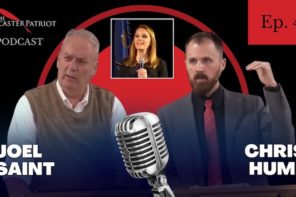An article being described as “explosive,” written by two allies of Pope Francis in a Vatican-reviewed publication, is taking on the “spurious alliance between politics and religious fundamentalism” in the United States.
Antonio Spadaro and Marcelo Figueroa call out the dominionist groups “composed mainly of whites from the deep American South” for their rejection of the “global ecological crisis” and their Armageddon-infused rhetoric, pointedly drawing parallels to Islamic fundamentalism.
They accuse these evangelical fundamentalists of seeking “influence in the political and parliamentary sphere and in the juridical and educational areas so that public norms can be subjected to religious morals.”
And, they name names:
This is the doctrine that feeds political organizations and networks such as the Council for National Policy and the thoughts of their exponents such as Steve Bannon, currently chief strategist at the White House and supporter of an apocalyptic geopolitics.
But it’s not just evangelical fundamentalists who desire “religious influence in the public sphere”:
Appealing to the values of fundamentalism, a strange form of surprising ecumenism is developing between Evangelical fundamentalists and Catholic Integralists. . . . Some who profess themselves to be Catholic express themselves in ways that until recently were unknown in their tradition and using tones much closer to Evangelicals. They are defined as value voters as far as attracting electoral mass support is concerned. . . . This meeting over shared objectives happens around such themes as abortion, same-sex marriage, religious education in schools and other matters generally considered moral or tied to values.
More than 15 years after the Catholic bishops helped get George W. Bush elected president and nearly eight after the signing of the Manhattan Declaration, the Vatican has discovered what had become the defining feature of the Christian Right in America: the conservative evangelical-Catholic convergence.
And while Spadaro and Figueroa are critical of the sublimation of gospel values to the goal of right-wing political domination, it’s worth noting that the two issues that drove this convergence in the first place—abortion and same-sex marriage—haven’t exactly been abandoned by Pope Francis.
As for the “glue” that holds this altogether—and formed the underpinning of the Manhattan Declaration coalition—Francis has been a proponent of the idea that the “religious liberty” of Catholics is under attack in western democracies such as the United States, even as Spadaro and Figueroa criticize its use for political ends:
The erosion of religious liberty is clearly a grave threat within a spreading secularism. But we must avoid its defense coming in the fundamentalist terms of a “religion in total freedom,” perceived as a direct virtual challenge to the secularity of the state.
While much of their criticism is justified, Spadaro and Figueroa are silent about the role that Pope John Paul II and Pope Benedict played in the creation of the “evangelical Catholics” they complain about and about the role that the U.S. Conference of Catholic Bishops played in driving conservative Catholics into the arms of the Republican Party, and, eventually, Trump.
Nonetheless, they correctly call-out the “shocking rhetoric” of the Church Militant and other pro-Trump organizations that are “openly in favor of a political ultraconservatism and uses Christian symbols to impose itself”:
. . . it has created a close analogy between Donald Trump and Emperor Constantine, and between Hilary Clinton and Diocletian. The American elections in this perspective were seen as a “spiritual war” . . . Church Militant asks if Trump’s victory can be attributed to the prayers of Americans. The response suggested is affirmative. The indirect missioning for President Trump is clear: he has to follow through on the consequences. This is a very direct message that then wants to condition the presidency by framing it as a divine election.
For conservatives, however, this is not political warfare cloaked as spiritual warfare, but a logical and necessary outcome of attacks on the traditional church. Philadelphia Archbishop Charles Chaput calls the article “an exercise in dumbing down and inadequately presenting the nature of Catholic/evangelical cooperation on religious freedom and other key issues”:
The cooperation of Catholics and evangelicals was quite rare when I was a young priest. Their current mutual aid, the ecumenism that seems to worry La Civilta Cattolica, is a function of shared concerns and principles, not ambition for political power. . . . Dismissing today’s attacks on religious liberty as a “narrative of fear”—as the La Civiltà Cattolica author curiously describes it—might have made sense 25 years ago. Now it sounds willfully ignorant. It also ignores the fact that America’s culture wars weren’t wanted, and weren’t started, by people faithful to constant Christian belief.
But Spadaro and Figueroa call this a false ecumenism, “an ecumenism of conflict that unites them in the nostalgic dream of a theocratic type of state” and that “wants walls and purifying deportations.” By contrast, they say, Francis’ ecumenism “moves under the urge of inclusion, peace, encounter and bridges.”
Regardless of whose brand of ecumenism you subscribe to, one thing is for sure. Francis, they say, “wants to break the organic link between culture, politics, institution and Church.” But this link underpins much of the conservative religious understanding in the United States today. And breaking it may take more than just words.





